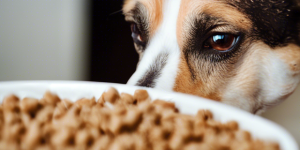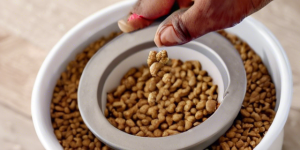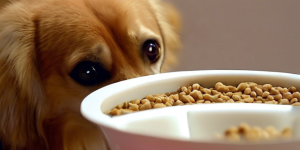Best Grain-Free Dog Food for Allergies 2024

Is your furry friend constantly scratching, licking their paws, or dealing with upset tummies? You might be dealing with a case of food allergies, and grain could be the culprit. Don’t worry, you’re not alone in this doggy dilemma! Many pet parents find themselves on a quest for the best grain-free dog food to help their allergic pups. In this comprehensive guide, we’ll sniff out the top grain-free options that could have your pooch feeling positively great again!
Why Go Grain-Free? Understanding Dog Food Allergies
Before we dive into our top picks, let’s chew on the basics of dog food allergies. Just like humans, dogs can develop allergies to certain ingredients in their food. While grains aren’t always the villain, they’re often suspects in the lineup of allergy-causing ingredients.
Common Symptoms of Food Allergies in Dogs
If your dog is showing any of these symptoms, they might be dealing with a food allergy:
- Itchy skin
- Excessive paw licking or chewing
- Ear infections
- Gastrointestinal issues (vomiting, diarrhea)
- Hot spots
- Chronic gas
Remember, these symptoms can also be caused by other health issues, so it’s always best to consult with your vet before making any major dietary changes. They’re like the Sherlock Holmes of the pet world – they can help you solve the mystery of your dog’s discomfort!
The Grain-Free Revolution: What’s the Deal?

Grain-free dog food has become increasingly popular in recent years. But what’s all the fuss about? Well, the theory is that dogs’ ancestors didn’t eat grains in the wild, so their digestive systems aren’t designed to handle them. While this is a bit of an oversimplification (dogs have evolved alongside humans for thousands of years), many dogs do seem to benefit from a grain-free diet.
According to the American Kennel Club, while grains aren’t inherently bad for dogs, some pups may have difficulty digesting them or may be allergic to specific grains. That’s where grain-free options come in handy!
Top Grain-Free Dog Food Brands for Allergies
Now, let’s get to the meat of the matter (pun intended)! Here are some of the best grain-free dog food brands that could help soothe your pup’s allergies:
1. Blue Buffalo Basics Limited Ingredient Diet
Blue Buffalo is like the cool kid on the block when it comes to pet food. Their Basics Limited Ingredient Diet line is a great option for dogs with allergies.
Key Features:
- Single animal protein source
- No chicken or beef
- Contains pumpkin for gentle digestion
Blue Buffalo uses high-quality ingredients and avoids common allergens. It’s like a gourmet meal for your pup, minus the stuff that upsets their tummy!
2. Merrick Limited Ingredient Diet
Merrick is another big player in the grain-free game. Their Limited Ingredient Diet recipes are designed with allergic dogs in mind.
Key Features:
- Single source of animal protein
- No grains, corn, wheat, or soy
- Added vitamins and minerals
Merrick’s recipes are like a simplified, allergy-friendly version of your dog’s favorite meal. They keep it simple, which is often exactly what allergic dogs need.
3. Taste of the Wild Pacific Stream
If your dog fancies a taste of the wild (see what I did there?), this brand might be right up their alley.
Key Features:
- Real salmon as the first ingredient
- Grain-free recipe
- Includes fruits and vegetables for natural antioxidants
Taste of the Wild is like taking your dog on a culinary adventure, without the ingredients that might upset their stomach.
4. Wellness Simple Limited Ingredient Diet
Wellness takes the “simple” in their name seriously, offering recipes with minimal ingredients to reduce the risk of allergic reactions.
Key Features:
- Single source of protein
- Limited ingredients
- No artificial additives
Think of Wellness Simple as the Marie Kondo of dog food – keeping only the ingredients that spark joy (and don’t cause allergies) in your pup!
5. Canidae PURE Limited Ingredient
Canidae PURE recipes are crafted for dogs with sensitive stomachs and food sensitivities.
Key Features:
- 7-10 key ingredients
- Grain-free recipes
- Probiotics added to every kibble
Canidae PURE is like a carefully curated menu for your dog, offering all the nutrition they need without the extras that might cause trouble.
6. Zignature Limited Ingredient Formula
Zignature takes pride in creating recipes with unique protein sources, perfect for dogs who are allergic to common proteins like chicken or beef.
Key Features:
- Novel protein sources (like kangaroo or guinea fowl)
- Low glycemic ingredients
- No corn, wheat, soy, or potatoes
Zignature is like the exotic food truck of the dog food world – offering unique flavors that are less likely to trigger allergies.
7. Instinct Limited Ingredient Diet
Instinct keeps things simple with their limited ingredient recipes, focusing on one animal protein and one vegetable.
Key Features:
- Single animal protein source
- One vegetable
- No dairy, eggs, potato, corn, wheat, or soy
Instinct’s approach is like a minimalist’s dream – keeping only what’s necessary and leaving out potential allergens.
Homemade Grain-Free Options: DIY Doggy Dining

Sometimes, the best solution is a home-cooked meal. If you’re feeling adventurous (and have gotten the green light from your vet), you might want to try your hand at making grain-free dog food at home.
Simple Grain-Free Dog Food Recipe
Here’s a basic recipe to get you started:
Ingredients:
- 1 pound lean ground turkey
- 1 cup cooked sweet potato
- 1 cup green beans
- 1 tablespoon olive oil
Instructions:
- Cook the ground turkey in a large skillet over medium heat until browned.
- Add the cooked sweet potato and green beans to the skillet.
- Drizzle with olive oil and mix well.
- Let cool before serving.
Remember, homemade diets should be balanced with the right nutrients. Consider adding a multivitamin supplement designed for dogs to ensure your pup is getting everything they need.
The Transition: Switching to Grain-Free
So, you’ve chosen a grain-free food for your allergic pup. Great! But hold your horses (or should I say, hold your puppies?). Switching dog food isn’t like flipping a light switch – it needs to be done gradually to avoid upsetting your dog’s stomach.
Here’s a suggested timeline for transitioning to new food:
- Days 1-2: 75% old food, 25% new food
- Days 3-4: 50% old food, 50% new food
- Days 5-6: 25% old food, 75% new food
- Day 7 onwards: 100% new food
This gradual transition is like easing your dog into a new lifestyle. It gives their digestive system time to adjust, reducing the likelihood of tummy troubles.
Beyond the Bowl: Other Allergy Management Strategies

While choosing the right food is crucial, managing your dog’s allergies goes beyond what’s in their bowl. Here are some additional strategies to help your allergic pup:
1. Regular Grooming
Frequent baths and brushing can help remove allergens from your dog’s coat. It’s like giving your dog a spa day that actually helps them feel better!
2. Omega-3 Fatty Acids
Adding a fish oil supplement to your dog’s diet can help reduce inflammation and improve skin health. Think of it as a beauty treatment from the inside out!
3. Probiotics
These beneficial bacteria can help improve gut health, which may in turn help with allergies. It’s like sending a peacekeeping force to your dog’s digestive system!
4. Environmental Allergen Control
Remember, food isn’t the only potential allergen. Keep your home clean and consider using an air purifier to reduce environmental allergens. It’s like creating a safe bubble for your sensitive pup.
5. Allergy Testing
If you’re still struggling to pinpoint your dog’s allergies, consider asking your vet about allergy testing. It’s like giving your dog a personalized allergy detective!
Reading Dog Food Labels: Becoming a Pet Food Detective
When you’re shopping for grain-free dog food, you’ll need to channel your inner Sherlock Holmes. Reading and understanding dog food labels is crucial in ensuring you’re getting a truly grain-free product that meets your pup’s nutritional needs.
Key Things to Look For:
- Protein Source: This should be the first ingredient listed. Look for named meats like “chicken” or “beef” rather than vague terms like “meat meal”.
- No Grains: Obviously, you want to avoid ingredients like wheat, corn, and rice. But be aware of less obvious grains like barley and oats.
- Limited Ingredients: Especially if your dog has multiple sensitivities, a limited ingredient diet can help you identify and avoid problem foods.
- Fruits and Vegetables: These provide essential vitamins, minerals, and fiber. Look for options like sweet potatoes, peas, and blueberries.
- Added Vitamins and Minerals: These ensure your dog is getting a complete and balanced diet.
- No Artificial Preservatives: Natural preservatives like Vitamin E (often listed as mixed tocopherols) are preferable.
Remember, the ingredient list is like your dog’s menu – you want to make sure everything on it agrees with their tummy!
The Great Debate: Wet vs. Dry Grain-Free Food
When it comes to grain-free dog food, you’ve got two main options: wet food and dry food. Each has its pros and cons, and the best choice often depends on your individual dog’s needs and preferences.
Wet Grain-Free Food
Pros:
- Higher moisture content (great for hydration)
- Often more palatable for picky eaters
- Can be easier to eat for dogs with dental issues
Cons:
- More expensive per serving
- Spoils faster once opened
- Can contribute to dental issues if it’s the only food given
Dry Grain-Free Food
Pros:
- More convenient to store and serve
- Often more cost-effective
- Can help keep teeth clean
Cons:
- Lower moisture content
- Some dogs may find it less palatable
- Can be harder for some dogs to digest
Many pet parents find that a combination of wet and dry food works best. It’s like giving your dog the best of both worlds!
The Role of Novel Proteins in Allergy Management
When dealing with food allergies, sometimes it’s not just about going grain-free. Enter novel proteins – the new kids on the block in the world of dog food.
Novel proteins are protein sources that your dog hasn’t been exposed to before. This could include meats like venison, duck, or even more exotic options like kangaroo or alligator. The idea is that if your dog hasn’t encountered these proteins before, they’re less likely to have developed an allergy to them.
Many grain-free dog foods for allergies incorporate novel proteins. It’s like introducing your dog to a whole new culinary world while avoiding potential allergens!
Grain-Free Doesn’t Mean Carb-Free: Understanding Alternative Carbohydrates
When you remove grains from dog food, something needs to take their place. This is where alternative carbohydrates come in. Common grain-free carb sources include:
- Sweet Potatoes
- Peas
- Lentils
- Chickpeas
- Potatoes
- Tapioca
These ingredients provide the energy and fiber that your dog needs. However, it’s important to note that some dogs may be sensitive to these ingredients as well. It’s like a dietary game of whack-a-mole – you solve one problem, but another may pop up!
The FDA has raised concerns about a potential link between grain-free diets high in legumes or potatoes and a heart condition called dilated cardiomyopathy (DCM) in dogs. While research is ongoing, it’s something to be aware of and discuss with your vet.
The Importance of Proper Nutrition: Beyond Allergy Management
While managing allergies is important, it’s crucial not to lose sight of your dog’s overall nutritional needs. A grain-free diet for allergies should still provide all the essential nutrients your dog needs to thrive.
Key nutrients to look for include:
- Protein: For muscle maintenance and growth
- Fat: For energy and healthy skin and coat
- Fiber: For digestive health
- Vitamins and Minerals: For overall health and immune function
Think of your dog’s diet like a symphony – each nutrient plays a crucial role, and they all need to work together harmoniously for your dog to be at their best.
When Grain-Free Isn’t Enough: Other Dietary Strategies for Allergies
Sometimes, switching to a grain-free diet isn’t enough to fully manage your dog’s allergies. In these cases, you might need to explore other dietary strategies:
- Elimination Diets: This involves feeding your dog a very limited diet and slowly reintroducing ingredients to identify specific allergens.
- Hydrolyzed Protein Diets: These diets use proteins that have been broken down into such small pieces that the immune system doesn’t recognize them as allergens.
- Raw Diets: Some pet parents swear by raw diets for allergy management, though it’s crucial to ensure these diets are nutritionally complete.
- Prescription Diets: In severe cases, your vet may recommend a prescription diet specifically formulated for dogs with food allergies.
Remember, managing your dog’s allergies is like solving a puzzle – sometimes you need to try different pieces before you find the one that fits!
The Bottom Line: Finding the Right Grain-Free Food for Your Allergic Dog
Choosing the best grain-free dog food for allergies is a journey, not a destination. It might take some trial and error to find the perfect fit for your furry friend. Here are some key takeaways to remember:
- Always consult with your vet before making significant changes to your dog’s diet.
- Transition to new foods gradually to avoid digestive upset.
- Pay attention to your dog’s response to new foods – are their allergy symptoms improving?
- Remember that grain-free isn’t necessarily best for all dogs – it’s about finding what works for your individual pup.
- Don’t forget about overall nutrition while focusing on allergy management.
- Be patient – it can take several weeks to see improvements in allergy symptoms after a diet change.
Finding the right food for your allergic dog is like finding the perfect pair of shoes – it needs to fit just right, be comfortable, and suit your (dog’s) lifestyle. With patience, persistence, and the information in this guide, you’re well on your way to helping your furry friend feel better.
So, are you ready to embark on this grain-free journey with your pup? Remember, every step you take is a step towards a happier, healthier, itch-free dog. And that’s something worth wagging a tail about!
FAQs
- Can dogs develop grain allergies later in life? Yes, dogs can develop allergies at any age, including grain allergies. If you notice new symptoms in your adult dog, it’s worth discussing with your vet. Just like humans, dogs’ bodies can change over time, and what once worked for them might not work anymore.
- Are all grain-free dog foods suitable for dogs with allergies? Not necessarily. While grain-free foods can be helpful for dogs with grain allergies, some dogs may be allergic to other ingredients commonly found in grain-free foods, such as certain proteins or vegetables. It’s important to identify your dog’s specific allergens and choose a food accordingly.
- How long does it take to see improvements after switching to a grain-free diet? It can take anywhere from a few weeks to a couple of months to see significant improvements in allergy symptoms after a diet change. Every dog is different, so be patient and consistent. If you don’t see any improvements after 8-12 weeks, it might be time to try a different approach or consult with your vet again.
- Can I mix grain-free and regular dog food? While it’s possible to mix foods, if you’re trying to determine if your dog has a grain allergy, it’s best to stick to a strictly grain-free diet. Mixing in regular food that contains grains could interfere with your ability to see
